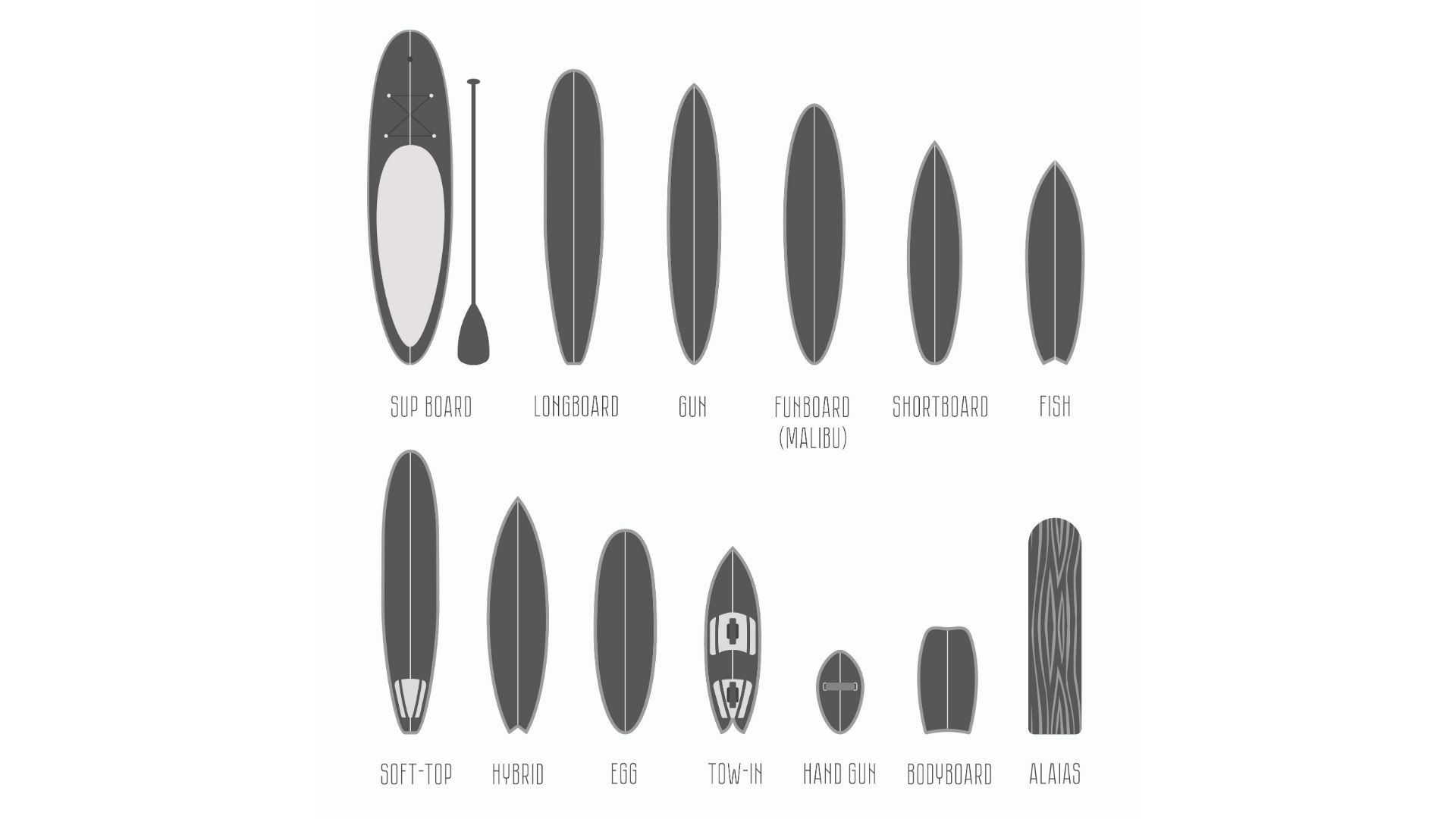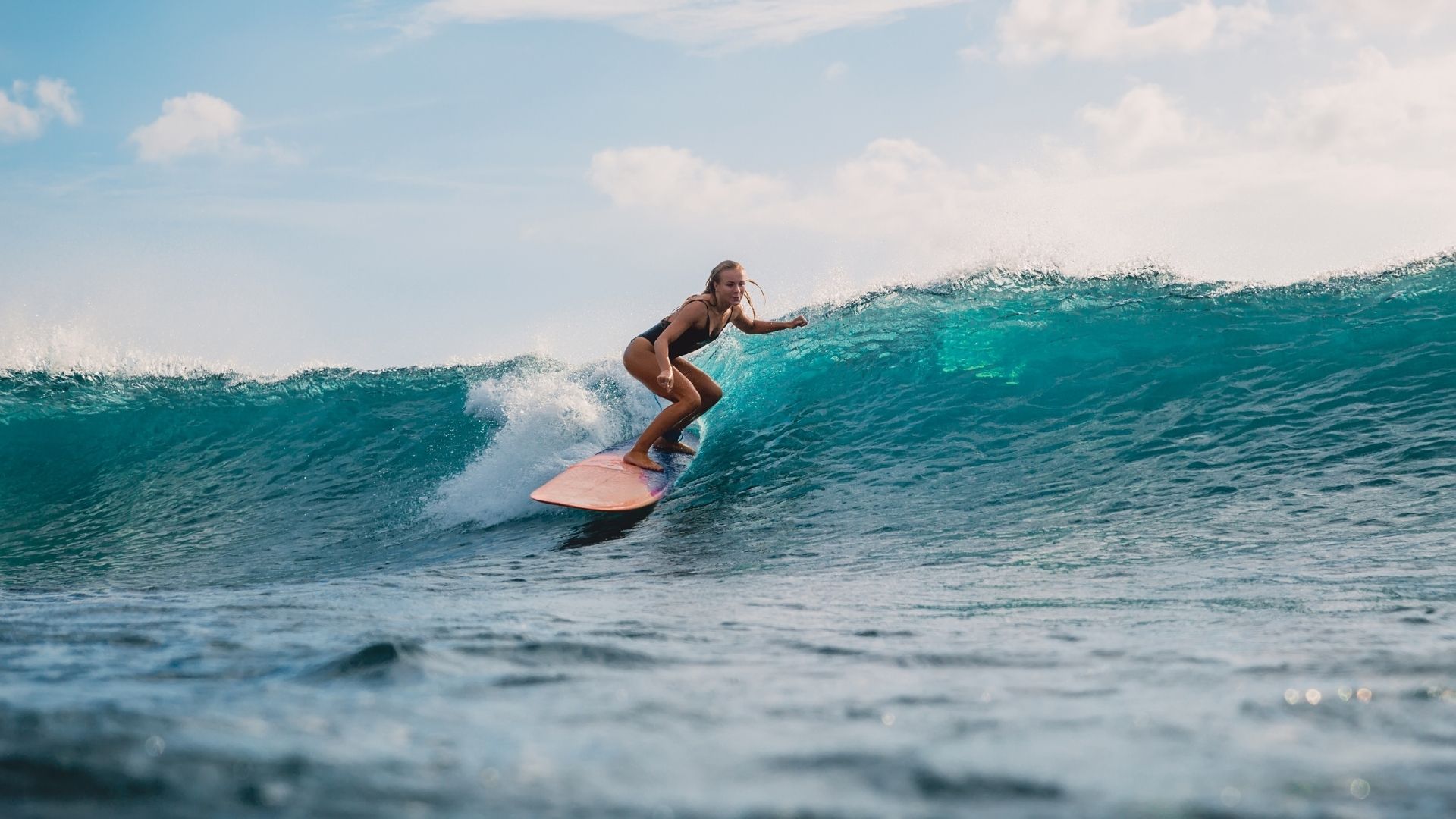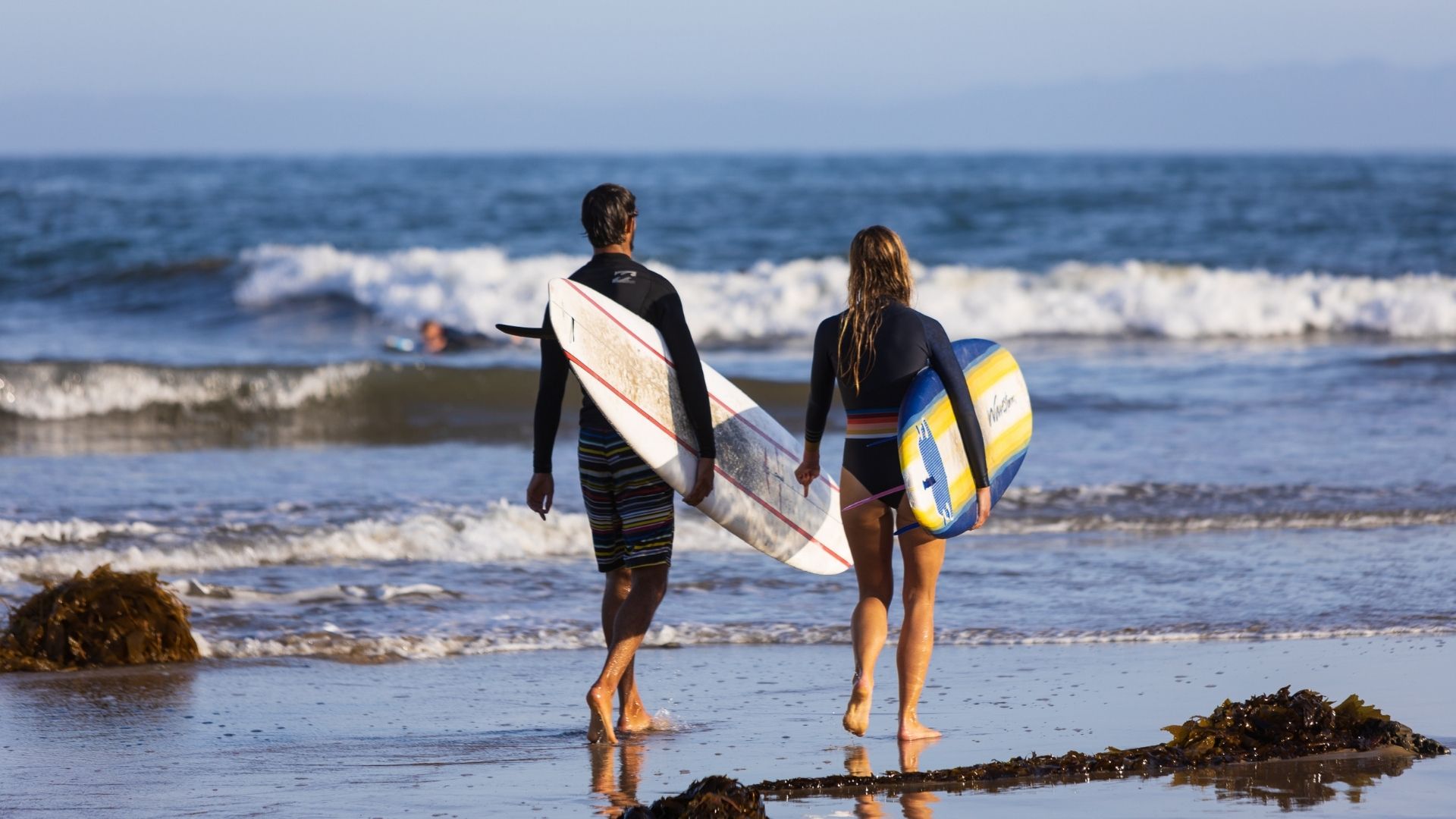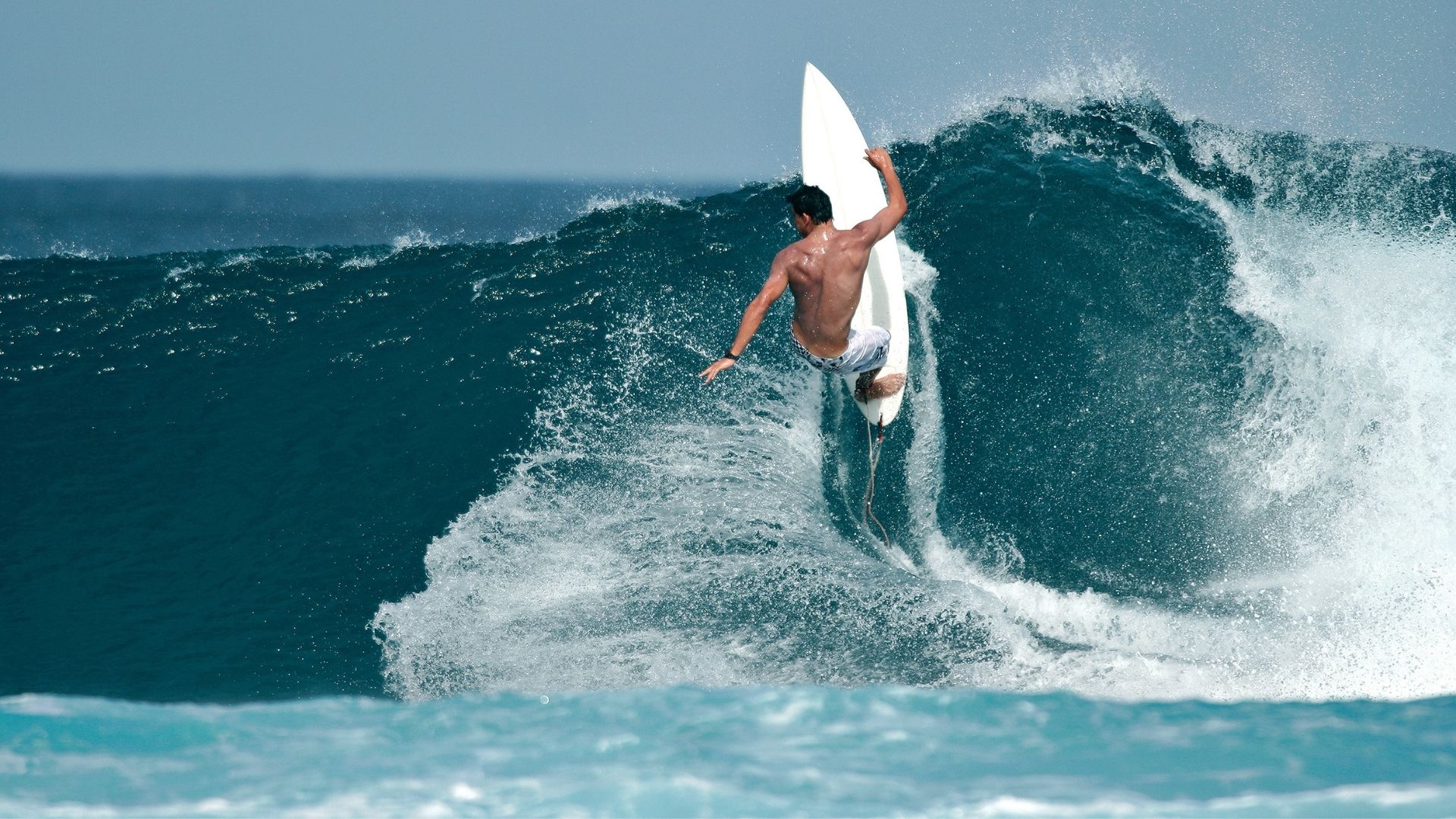Like everything in life, Size Matters!
And, when it comes to surfboards, determining which size surfboard to ride is directly proportional to the amount of fun you will have in the waves.
Go too short, and you won’t be able to catch any waves. Go too long and you will struggle to even walk to the beach, let alone get out to the lineup!
In this article, I’ll cover everything you need to know about surfboard sizing. Whether you’re a beginner surfer, or have some experience surfing, I’ll help you choose a surfboard that’s right for you!

What Size Surfboard Should I Get?
There are a load of different surfboard shapes out there. Determining which is the best beginner surfboard for you is based on a few factors.
Your size (height and weight)
Your fitness
Your surfing ability or experience
The right surfboard will be suited to the waves you want to surf too – Don’t opt for something too pointy and thin if you are surfing mellow smaller waves.
The reason is – you will need a big beginner-style surfboard to catch these mellow waves.
And just like you would get a wet suit that fits your height and weight, a surfboard is no different.
What Size Surfboard Do I NEED?
One of the first steps to catching waves as a beginner surfer is finding the right size board for your height, weight, and skill level.
The size of a surfboard, or really, we should say surfboard length, is generally categorized into a few main groups like longboards, shortboards, mid-lengths, and funboards/hybrids.
So what size surfboard should you start out on, and how do you choose the ideal length as you progress?
Let’s break down the key measurements for board sizing to help you pick your perfect magic carpet.
If you are a total newbie, go as big as you can carry.
In a previous life when I would sell surfboards for a living, I would go by this basic rule.
Small Adults and Big Kids > 7ft foam surfboard
Regular Adult Size > 8ft foam surfboard
Big Adults > 9ft foam surfboard
If you have already done a bit of surfing and had a few lessons on foam surfboards, you can probably graduate onto a ‘hard board’ made of foam and fiberglass.
These are a lot more responsive than foamies, allowing you to learn to turn, getting the rail in the water, and starting to perform basic maneuvers.
Factors That Impact Your Surfboard Size
Like I said earlier, selecting a board that’s a good fit for you is based on a combination of your:
- Height and weight – So a taller or heavier rider will need more surface area and volume to stay afloat.
- Skill level – Beginners typically start bigger for increased paddle power, float and stability.
- Wave conditions – Bigger waves have a lot more power, so weirdly you actually ride a smaller board in bigger surf (but when the waves get really big you need a bigger board to actually get enough speed to catch them).
Different Types of Surfboards
Of course different types of boards are easier to paddle than others. Generally speaking, a longer board will be much easier to paddle than a smaller board.
BUT, the length alone is not the determining factor.
You need to consider the overall shape of the board and how the foam is distributed. For example, an 8ft board that is really thin and pointy, is not going to perform the same as an 8ft mini mal or funboard that has a ‘lollipop shaped’ nose.
If you haven’t done a whole lot of surfing, opt for the latter.
The reason is you will be able to paddle that wider board more easily.
Because you can paddle it more easily you will catch more waves.
And when you catch more waves you will progress a lot faster.

Longboard Sizes
Longboards, as the name suggests, are the longest and most voluminous style of board, ranging from 9 to 10+ feet in length.
Their increased size makes them most stable for beginners trying to stand up and balance initially.
The extra surface area also means longboards catch waves earlier and provide ample speed gliding across the water.
The ideal dimensions for a longboard depend on your measurements:
Pretty much any size longboard is a good way to start – but be mindful of
- How you are going to store the board
- How you are going to get it to the beach (will it fit in your car for instance)
Another option when it comes to longboards is a narrower “performance longboard”. These allow for more speed and maneuvers than wider, traditional logs. But the added length keeps them forgiving to learn on regardless.
If you like the idea of being a longboarder, getting a longboard as a beginner is a great idea.
They are easy to paddle and to catch loads of waves, but the downside is they can be difficult to get out into the lineup if the waves are big and/or powerful.
For stand-up paddling, you can expect anything from 7 to 12 foot long depending on how you’re hoping to ride. SUPer’s get a pretty bad rep in the line-up, but standing up can give access to surfers who might not otherwise be riding waves. Innovated in part by the legendary Duke Kahanamoku, SUPing has taken on the global surfing community like a firestorm. My advice? Remember to share the peak with us lowly prone paddlers.
A lot of purist short boarders might say that a longboard hinders your maneuverability, and in some cases, you might be right. The shape of your board, beyond the length, will make a big difference in how you’re surfing.
Pin-tail, squash-tail, swallowtail, whatever you choose for your extra-long stick should sync with your surf style, ability, and favorite spots.
If you’re looking to have plenty of maneuverability and still ride the nose, consider something around 9’6”.
A good rule of thumb for choosing your surfboard is the more angular your tail, the more angular your turns will be.
→ Swallowtails typically allow you to hug the rail after quick and sometimes abrupt bottom turns and cutbacks.
→ Pintails are likely to help you round out your turns smoothly while maintaining speed.
→ Squash tails, by comparison, will allow you to stall towards the end of your cutback before reintroducing to the face and heading back down the line.
Expert tips: keep it above 8 feet, and don’t place your fin too far back.
Midlength Boards, Funboards and Hybrids
Splitting the difference are midlengths and funboards. These are generally sized between around 7’0″ to 8’6″, blending some benefits of longboards and shortboards.
Mid-length boards go by several different names from eggs and fun-boards to retro style single fins and mini-guns. These are ideal for intermediate to hell-man kamikaze-style surfers.
A mid-length board comes with a certain amount of style and allows you the opportunity to step up when waves get extra big or extra small. Surfers who choose a mid-length may be looking for a session void of spaghetti arms and filled with well-rounded maneuvers.
A thruster pushing 6’8” with a little extra volume will give you the chance to drop in early on especially hollow days or long slow rollers. While a 7’0” round pin might win a few extra points on a smaller day and won’t be a hassle to paddle in big surf. Many mid-length surfers look for something with just a little bit of rocker, or curvature towards the nose, while others may prefer plenty. A board with less rocker will plane on to the face quicker when paddling into small waves while extra volume with plenty of rocker will keep you dropping in on steep faces and hitting the lip.
The slightly downsized length still holds decent stability for learning stages, while allowing moderate speed and turns as skills improve.
As a general guide for an average surfer, use this sizing as a rough guide.
- Surfer Height 5′ to 5’5″ – Look for a 7’6″ to 8′ board
- Surfer Height 5’6″ to 6′ tall – Opt for 8′ to 8’6″ models
- Surfer Height 6’1″ and up – Size up around 9′ range
Depending on the shape that you select, you may not be compromising maneuverability at all. You can expect to shred the face just as well as your 5’8” fish. Speaking of fish, while not precisely a mid-length board, many shorter fishes are an excellent substitute for Longboards or mid-lengths on smaller days.
You can expect whiplash-inducing maneuvers regardless of shape or speed of the wave you’re riding. A fish with a little extra volume can again help with your paddle strokes and maintain your maneuverability without compromising your street cred.
Expert tips: Consider demo-ing a few boards at a local surfing event or surf shop before settling on the mid-length board of your choice. If you’re not looking to break the bank – head for your nearest garage sale or website that sells used surfboards.
These sorts of boards allow a gradual transition from pure stability toward increased performance and wave count. This makes them a quiver staple even for lifelong surfers.
A midlength or funboard is a really versatile surfboard to have in your quiver. Great for small waves, and for kids or beginners to have a try. And once you have a low intermediate ability can be used in all manner of conditions.
What’s the difference between a midlength and a funboard?
Good question: My answer is this – the nose is narrower on a mid length and the person who rides it has tattoos (just kidding).
Seriously though, mini mals, and funboards do tend to have more foam and volume up front, which make them great for paddling, and a mid length will have slightly less foam, and will be a little more responsive and able to fit better ‘in the pocket’ of the wave.
Short Board Surfboards
With the complexity and sophistication of surfboard design these days, it’s hard to lump all boards under 7’0” in the same category.
On the marketplace today you’re likely to find an assortment of elliptical, asymmetrical, and even rectangular surfboards. Again, before purchasing your board, you’ll want to consider the conditions where you hope to surf, and your personal preference or surfing style.
Are you hoping to carve down the face, drop-in late to the barrel, or throw the occasional pop-shove-it.
The most significant difference between a shortboard and a longer board is that short boarders need to strategically place themselves on the face of the wave to build, release, and redirect speed.
On smaller days, you may see surfers thrashing up and down the face to build momentum for a straightforward cutback.
While under fast and hollow conditions, you’ll find short boarders stalling for the tube and lengthening bottom turns to cut back across the lip.
Shortboards give you a higher command of your maneuverability, for better or worse.
For this reason, many new and beginner surfers might find shortboards unappealing.
Shortboards aren’t as forgiving to rolling down the windows and involuntary body movements. Surfers on a shortboard need to be comfortable, quick, and intentional to maintain momentum and stay in a good surfing position.
When you’re first learning to paddle, drop-in, or cut down the line, building speed to stay ahead of the section might be a bit outside your learning curve. Intermediate and experienced surfers may prefer to ease down towards a shorter board through transitioning toward a mid-length.
While building speed is essential, the most important lesson to learn before paddling out on a shortboard is wave-sense. Shortboarders need a steeper wave face to drop-in. Wave-sense keeps surfers from taking too many on-the-head or hugging too close to the shoulder.
Rent Before You Buy
To really dial in what length board is perfect for you, I’d recommend trying out different sizes of rental boards first.
This will give you a feel for how various dimensions feel different out in the waves. Pay attention to how easy each is to paddle out, pop up, turn, and ride down the line.
Try to experiment in the type of waves you ride too.
Don’t overthink the decision. Grab a board and get in the water!
Surfboard Buying Tips for Your First Surfboard
For your first board, my advice would be without a doubt to head to your local surf shop – if you have one that is! Don’t understate the experience they will be able to offer to help you choose the best beginner surfboard to get started.
And to buy the right board, be as honest with yourself as you can.
How often will you surf? How fit are you?
Answering a few questions honestly will help you buy a board that will not only get you in the water catching waves but will also help you make progress and improve in no time!




